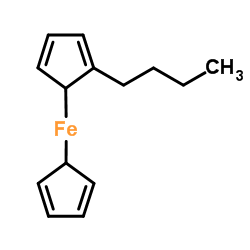Butylferrocene
Modify Date: 2025-08-20 10:52:24

Butylferrocene structure
|
Common Name | Butylferrocene | ||
|---|---|---|---|---|
| CAS Number | 31904-29-7 | Molecular Weight | 242.138 | |
| Density | 1.172 | Boiling Point | 232 °C (630 mmHg) | |
| Molecular Formula | C14H18Fe | Melting Point | 10 - 12ºC | |
| MSDS | N/A | Flash Point | >110°C | |
| Name | Butylferrocene |
|---|---|
| Synonym | More Synonyms |
| Density | 1.172 |
|---|---|
| Boiling Point | 232 °C (630 mmHg) |
| Melting Point | 10 - 12ºC |
| Molecular Formula | C14H18Fe |
| Molecular Weight | 242.138 |
| Flash Point | >110°C |
| Exact Mass | 242.075790 |
| LogP | 3.60090 |
| Index of Refraction | 1.576-1.579 |
| Stability | Stable, but may be air sensitive. Incompatible with strong oxidizing agents. |
Synonym: Section 2 - COMPOSITION, INFORMATION ON INGREDIENTS
Risk Phrases: None Listed. Section 3 - HAZARDS IDENTIFICATION EMERGENCY OVERVIEW
Air sensitive. Potential Health Effects Eye: May cause eye irritation. Skin: May cause skin irritation. Ingestion: May cause irritation of the digestive tract. The toxicological properties of this substance have not been fully investigated. Inhalation: May cause respiratory tract irritation. Chronic: Not available. Section 4 - FIRST AID MEASURES Eyes: Flush eyes with plenty of water for at least 15 minutes, occasionally lifting the upper and lower eyelids. Get medical aid. Skin: Get medical aid. Flush skin with plenty of water for at least 15 minutes while removing contaminated clothing and shoes. Ingestion: Get medical aid. Wash mouth out with water. Inhalation: Remove from exposure and move to fresh air immediately. If not breathing, give artificial respiration. If breathing is difficult, give oxygen. Get medical aid. Notes to Physician: Section 5 - FIRE FIGHTING MEASURES General Information: As in any fire, wear a self-contained breathing apparatus in pressure-demand, MSHA/NIOSH (approved or equivalent), and full protective gear. Extinguishing Media: Use water spray, dry chemical, carbon dioxide, or chemical foam. Section 6 - ACCIDENTAL RELEASE MEASURES General Information: Use proper personal protective equipment as indicated in Section 8. Spills/Leaks: Absorb spill with inert material (e.g. vermiculite, sand or earth), then place in suitable container. Section 7 - HANDLING and STORAGE Handling: Avoid breathing dust, vapor, mist, or gas. Avoid contact with skin and eyes. Storage: Store in a cool, dry place. Store in a tightly closed container. Section 8 - EXPOSURE CONTROLS, PERSONAL PROTECTION Engineering Controls: Use adequate ventilation to keep airborne concentrations low. Exposure Limits CAS# 31904-29-7: Personal Protective Equipment Eyes: Not available. Skin: Wear appropriate protective gloves to prevent skin exposure. Clothing: Wear appropriate protective clothing to prevent skin exposure. Respirators: Follow the OSHA respirator regulations found in 29 CFR 1910.134 or European Standard EN 149. Use a NIOSH/MSHA or European Standard EN 149 approved respirator if exposure limits are exceeded or if irritation or other symptoms are experienced. Section 9 - PHYSICAL AND CHEMICAL PROPERTIES Physical State: Liquid Color: orange - brown Odor: Not available. pH: Not available. Vapor Pressure: Not available. Viscosity: Not available. Boiling Point: 232 deg C @ 630.00m Freezing/Melting Point: Not available. Autoignition Temperature: Not available. Flash Point: > 110 deg C (> 230.00 deg F) Explosion Limits, lower: Not available. Explosion Limits, upper: Not available. Decomposition Temperature: Solubility in water: insoluble Specific Gravity/Density: Molecular Formula: Molecular Weight: 242.14 Section 10 - STABILITY AND REACTIVITY Chemical Stability: Not available. Conditions to Avoid: Incompatible materials, exposure to air. Incompatibilities with Other Materials: Strong oxidizing agents. Hazardous Decomposition Products: Carbon monoxide, carbon dioxide. Hazardous Polymerization: Will not occur. Section 11 - TOXICOLOGICAL INFORMATION RTECS#: CAS# 31904-29-7 unlisted. LD50/LC50: Not available. Carcinogenicity: n-Butylferrocene - Not listed by ACGIH, IARC, or NTP. Section 12 - ECOLOGICAL INFORMATION Section 13 - DISPOSAL CONSIDERATIONS Dispose of in a manner consistent with federal, state, and local regulations. Section 14 - TRANSPORT INFORMATION IATA Not regulated as a hazardous material. IMO Not regulated as a hazardous material. RID/ADR Not regulated as a hazardous material. Section 15 - REGULATORY INFORMATION European/International Regulations European Labeling in Accordance with EC Directives Hazard Symbols: Not available. Risk Phrases: Safety Phrases: S 24/25 Avoid contact with skin and eyes. WGK (Water Danger/Protection) CAS# 31904-29-7: No information available. Canada CAS# 31904-29-7 is listed on Canada's DSL List. CAS# 31904-29-7 is not listed on Canada's Ingredient Disclosure List. US FEDERAL TSCA CAS# 31904-29-7 is listed on the TSCA inventory. SECTION 16 - ADDITIONAL INFORMATION N/A |
| Hazard Codes | Xn,Xi,T |
|---|---|
| Risk Phrases | R22:Harmful if swallowed. R36/37/38:Irritating to eyes, respiratory system and skin . R25:Toxic if swallowed. |
| Safety Phrases | 24/25 |
| RIDADR | UN 2811 |
| WGK Germany | 3 |
| RTECS | US7548000 |
| Packaging Group | II |
| Hazard Class | 6.1 |
| HS Code | 29333999 |
| Precursor 2 | |
|---|---|
| DownStream 0 | |
| HS Code | 29333999 |
|---|
| n-Butylcyclopentadienyl cyclopentadienyliron |
| Butylferrocene |
| 1,1'-di-n-butylferrocenium |
| EINECS 250-862-9 |
| butyl-ferrocen |
| Ferrocene, butyl- |
| MFCD00001435 |
| 1,1'-di-n-butylferrocene |
| N-BUTYLFERROCENE |
| Ferrocene,butyl |
 CAS#:7439-89-6
CAS#:7439-89-6 CAS#:766-29-0
CAS#:766-29-0
